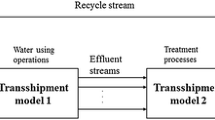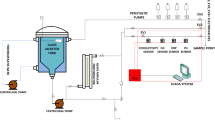Abstract
For effective flowsheet-level calculation of a complex chemical plant, the use of suitable partitioning and tearing techniques is inevitable. The partitioning and tearing techniques based on the reachability matrix and the decomposition algorithm were applied to model and simulate a sulfolane extraction plant. Basic concepts were first exploited towards a general representation for the modeling and simulation of the sulfolane extraction process. Six process units, which consist of the sulfolane extraction plant, were modeled first and partitioning and tearing techniques were employed to model and simulate the whole extraction plant. The Inside-Out method and the sequential-modular approach were used in the modeling and simulation. Results of simulations showed good agreement with plant operation data.
Similar content being viewed by others
References
Bailes, C. and Hughes, M. A., “Liquid-Liquid Extraction : Nonmetallic Materials,”Chem. Eng., May, 119 (1976).
Boston, J. F. and Sullivan, S. L., “A New Class of Solution Methods for Multicomponent,” Multistage, Separation Processes,”Can. J. Chem. Eng.,52, 52 (1974).
Choo, J. O., Yeo, Y. K., Kim, M. K., Kim, K. S. and Chang, K. S., “Modeling and Simulation of a Sulfolane Process,”Korean J. Chem. Eng.,15, 90 (1998).
Crowe, C. M. and Nishio, M., “Convergence Promotion in the Simulation of Chemical Processes-The General Dominant Ei-genvalue Method,”AIChE J.,21, 656 (1975).
Genna, P. L. and Motard, R. L., “Optimal Decomposition of Process Networks,”AIChE J.,21, 656 (1975).
Mah, R. S. H., “Chemical Process Structures and Information Flows,” Butterworths (1990).
Metcalfe, S. R. and Perkins, J. D.,Trans IchemE,56, 210 (1978).
Ollero, P. and Amselem, C., “Decomposition Algorithm for Chemical Process Simulation,”Chem. Eng. Res. Des.,61, September, 303 (1983).
Upadhye, R. S. and Grens II, E. A., “Selection of Decompositions for Chemical Process Simulation,”AIChE J.,21, 136 (1975).
Author information
Authors and Affiliations
Corresponding author
Rights and permissions
About this article
Cite this article
Cho, KW., Yeo, YK. & Kim, M.K. Application of partitioning and tearing techniques to sulfolane extraction plant. Korean J. Chem. Eng. 16, 462–469 (1999). https://doi.org/10.1007/BF02698269
Received:
Accepted:
Issue Date:
DOI: https://doi.org/10.1007/BF02698269




